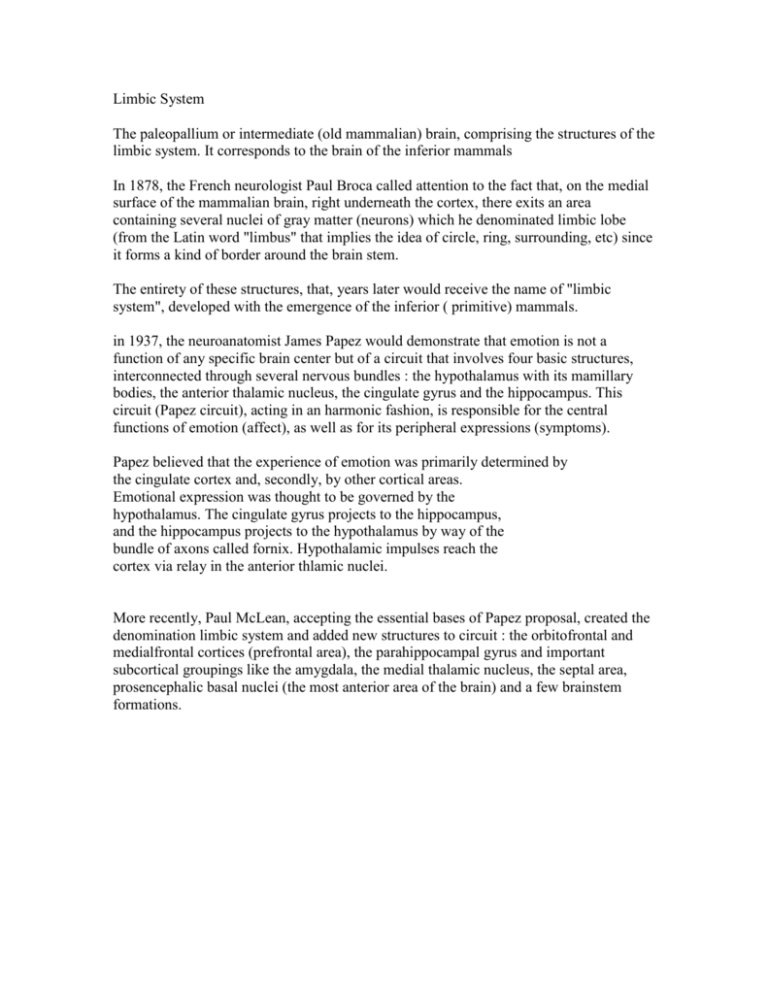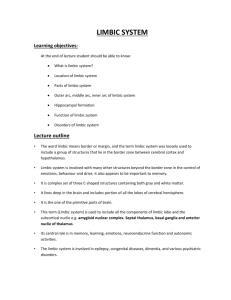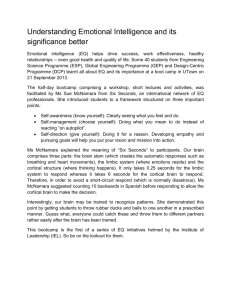Limbic System
advertisement

Limbic System The paleopallium or intermediate (old mammalian) brain, comprising the structures of the limbic system. It corresponds to the brain of the inferior mammals In 1878, the French neurologist Paul Broca called attention to the fact that, on the medial surface of the mammalian brain, right underneath the cortex, there exits an area containing several nuclei of gray matter (neurons) which he denominated limbic lobe (from the Latin word "limbus" that implies the idea of circle, ring, surrounding, etc) since it forms a kind of border around the brain stem. The entirety of these structures, that, years later would receive the name of "limbic system", developed with the emergence of the inferior ( primitive) mammals. in 1937, the neuroanatomist James Papez would demonstrate that emotion is not a function of any specific brain center but of a circuit that involves four basic structures, interconnected through several nervous bundles : the hypothalamus with its mamillary bodies, the anterior thalamic nucleus, the cingulate gyrus and the hippocampus. This circuit (Papez circuit), acting in an harmonic fashion, is responsible for the central functions of emotion (affect), as well as for its peripheral expressions (symptoms). Papez believed that the experience of emotion was primarily determined by the cingulate cortex and, secondly, by other cortical areas. Emotional expression was thought to be governed by the hypothalamus. The cingulate gyrus projects to the hippocampus, and the hippocampus projects to the hypothalamus by way of the bundle of axons called fornix. Hypothalamic impulses reach the cortex via relay in the anterior thlamic nuclei. More recently, Paul McLean, accepting the essential bases of Papez proposal, created the denomination limbic system and added new structures to circuit : the orbitofrontal and medialfrontal cortices (prefrontal area), the parahippocampal gyrus and important subcortical groupings like the amygdala, the medial thalamic nucleus, the septal area, prosencephalic basal nuclei (the most anterior area of the brain) and a few brainstem formations. Limbic System Rolf Kötter C. & O. Vogt Brain Research Institute and Dept. of Morphological Endocrinology & Histochemistry, Heinrich Heine University, Universitätsstr. 1, D-40225 Düsseldorf, Germany. Phone + fax: +49-211-8112095, e-mail: RK@hirn.uni-duesseldorf.de, URL: http://www.hirn.uni-duesseldorf.de/rk. In the neurosciences we find a profusion of references to "limbic system", as well as to "limbic" structures and "limbic" functions. "Limbic system" concepts can be encountered on all descriptive levels from molecular to large-scale system approaches, and they are frequently mentioned in experimental studies as well as in clinical case reports. Macroscopically, the term "limbic" is derived from the seam-like arrangement of cortical structures at the junction of the hemispheres with the diencephalon and brain stem. Over the last century this original concept was refined, revised and extended repeatedly to reflect new methodological approaches and to attribute function to its structural arrangement. Rather than leading to a firmly established concept, these advances paradoxically resulted in a multitude of more or less precise, partially unrelated and partially contradictory, definitions of "limbic" structures and functions. The following structures are most commonly regarded as components of the "limbic system": * cingulate gyrus with cingulum bundle * hippocampus including indusium griseum, dentate gyrus and fornix * parahippocampal gyrus including entorhinal cortex * amygdala * septal nuclei * parts of thalamus and hypothalamus (specifically those connected with the above structures) Various subsets of these structures feature - together with additional structures - in closely related concepts including "rhinencephalon", "Papez circuit", "visceral brain", "memory system", "emotional brain" or "limbic basal ganglia-thalamo-cortical circuit". "Limbic system" has become a key word associated with emotions and other functions involved in "preservation of the self and the species": memory, neuroendocrine control, sexual behavior, psychic integration, personality etc. Dysfunction of the "limbic system" is consequently thought to be a characteristic of neuro-psychiatric syndromes such as (temporal lobe) epilepsy, Gilles-de-la-Tourette syndrome, amnesia, anxiety or schizophrenia. The multiple definitions of "limbic system" A common view of "limbic system" is limited to cortical structures ("limbic cortex"): The C-shaped topography of cingulate gyrus and hippocampal region ("gyrus fornicatus") is completed by Broca with olfactory tract and bulb, together forming the racket-shaped "limbic lobe". This concept is related to the older entity of the "rhinencephalon" ("olfactory brain"), and their proximity was reflected until recently in textbooks dealing with "limbic" and olfactory systems under a common heading. A modern connectivitybased concept of "limbic cortex" by Lopes da Silva and co-workers is equally based on the "gyrus fornicatus" but closes its gap with reciprocal fiber projections linking the subcallosal area with the hippocampal regions. Subcortical structures are added to the "gyrus fornicatus" in the classical "Papez circuit" consisting of hippocampus, hypothalamus, anterior thalamic nucleus, cingulate gyrus and their interconnections. Originally proposed to form a mechanism of emotional experience and expression, most neuroscientists would nowadays associate the amygdala with (negative) emotions, but exclude the hippocampus as a non-emotional "cognitive" structure. The conglomerate of Broca’s "limbic lobe", Papez circuit and further brain structures is synthesized by MacLean to the "visceral brain", and then renamed the "limbic system" as the center of neuroendocrine regulation and emotions. In addition, lesions of various "limbic" structures can lead to striking memory impairments. Particularly well investigated is the inability of humans and other primates to acquire new memories after extensive bilateral medial temporal lobe lesions. Other lesions to "limbic" structures evoke complex disorders of personality, cognition or consciousness. Fresh attempts to establish the extent of the "limbic system" by cytoarchitectonics, histochemistry, connectivity studies or electrophysiology contribute further anatomical variety involving parts of neocortex, basal ganglia and brain stem (specifically insular cortex, nucleus accumbens and formatio reticularis, respectively). These observations have been conceptualized both in horizontally oriented hierarchical and in vertically oriented parallel processing models of the brain. The former is most clearly expressed in MacLean’s "triune brain" concept of three evolutionarily stacked brain developments, where the "limbic system" is seen to interface the "reptilian" brain stem with the mammalian neocortex. Parallel processing of "limbic" and non-"limbic" modalities in cortical as well as subcortical structures is a characteristic of the basal ganglia-thalamocortical loops proposed by Alexander and co-workers. Perhaps the most common feature among "limbic system" concepts is their tendency to closed loop arrangements as a morphological substrate for assumed reverberatory activity (see Lopes da Silva et al.). The proximity of such concepts to cybernetics and systems theory is obvious. Nowadays, the term "limbic" may relate to a multitude of different and partly contradictory structural and functional conglomerates throughout the entire brain. Even with regard to its core structures the emphasis shifts between cingulate gyrus, hippocampus, amygdala, hypothalamus and brain stem. Simultaneously, most properties thought to characterize "limbic system" are not unique to this system but also apply to other non-"limbic" brain structures. Most strikingly, some disturbances of memory, emotional or cognitive processes attributed to "limbic system" disorders are known to occur with isocortical, particularly prefrontal and parietal lesions. "Preservation of the self and the species" is such a comprehensive concept that no part of the brain is excluded from it. Restricted and unique definitions of "limbic system" arise from adherence to a single experimental method and definitory criterion, such as cytoarchitectonical delineation of archicortex or histochemical detection of "limbic system-associated protein". Assuming that remaining expert arguments about precise detection thresholds can be resolved, such investigations lead to enumerations of brain structures with poor justification of "limbic" or "system" terminology. In particular, definitions based on single structural criteria remain functionally meaningless since the hope that additional methods would afford converging evidence of a unique "limbic system" has so far remained elusive. Practical use of the term "limbic system" The confusion created by divergent "limbic system" concepts has raised a controversy about the usefulness and the appropriate use of this term. Brodal and Blessing argue that both structural and functional aspects of "limbic system" concepts are too comprehensive and too vague to serve as scientific explanations or as useful heuristics; therefore the use of the term should be abandoned. Isaacson and others strongly object since "limbic system" concepts capture integrative aspects that are not represented adequately by other neuroscientific concepts and that are lost by reduction of "limbic system" to individual structural or functional components. In defense of vague "limbic system" definitions they point out that a degree of fuzziness of system concepts (also "sensory" or "motor systems") can never be avoided and would even be expected if brain systems overlap or interact. Indeed, most researchers would agree that the brain structures listed above are densely interconnected and cannot be subsumed under sensory or motor systems. Only recently, multivariate statistical analyses of structural and functional connectivity afford quantitative evidence of the global organization of cortical systems including a cluster of orbito-temporo-insular areas. Thus, the core controversy is not about existence or nonexistence, but about the use of precise terminology and the formulation of heuristically useful concepts. The current state of research leads to the following guidelines for appropriate use of "limbic system" terminology: 1. Establish the precise structures or functions that "limbic" refers to. Since the definitions of "limbic system" vary widely and no generally accepted account can be referred to, it is of particular importance to be able to verify exactly which structures, functions or mechanisms are meant when speaking, for example, of "limbic epilepsy", "limbic encephalitis" or "limbic dysfunction". 2. If possible, replace the term "limbic" by a more precise term. When used in a restricted sense, "limbic" can often be substituted by more specific and precise terms, e.g. "limbic cortex" = allo- and periallocortex; "limbic" thalamus = anterodorsal, anteroventral and anteromedial nuclei; "limbic" inputs = afferents from amygdala and hippocampus. 3. Be aware of "limbic" as a catch phrase to attract a larger audience. Unfortunately, "limbic" is not only a convenient shorthand term used in titles and abstracts but also a common catch phrase in papers that deal with uni-modal descriptions rather than global system concepts and structure-function relationships. 4. Do not draw upon "limbic system" concepts for building new hypotheses. Since we lack a thorough understanding of, for example, the role of the amygdala or dopaminergic midbrain areas in emotional mechanisms, their projections to the ventral striatum (nucleus accumbens, "limbic system-motor interface") are poor explanations of how emotions can affect motor behavior. 5. Do not mistake "limbic system" concepts for detailed scientific explanations. "Limbic system" concepts imply explanatory mechanisms linking brain structures and functions. It may be their strength that they point to important unanswered questions in brain research, such as the mechanisms of emotions, consciousness or the self. There is a danger, however, that this simple and convenient term is confused with scientific explanations that still need to be worked out. Fig. 1. "Great limbic lobe" according to Broca (1878) Rev. Anthropol. 1, 385-498. G. = Gyrus; Tr. = Tractus. Fig. 2. "Limbic cortex" and area numbers according to Lopes da Silva et al. (1990) Physiol. Rev. 70, 453-511. Fig. 3. "Limbic basal ganglia-thalamo-cortical circuit" according to Alexander et al. (1986) Ann. Rev. Neurosci. 9, 357-382. Nucl. medialis dorsalis p. mc. = Nucleus medialis dorsalis thalami pars magnocellularis.









